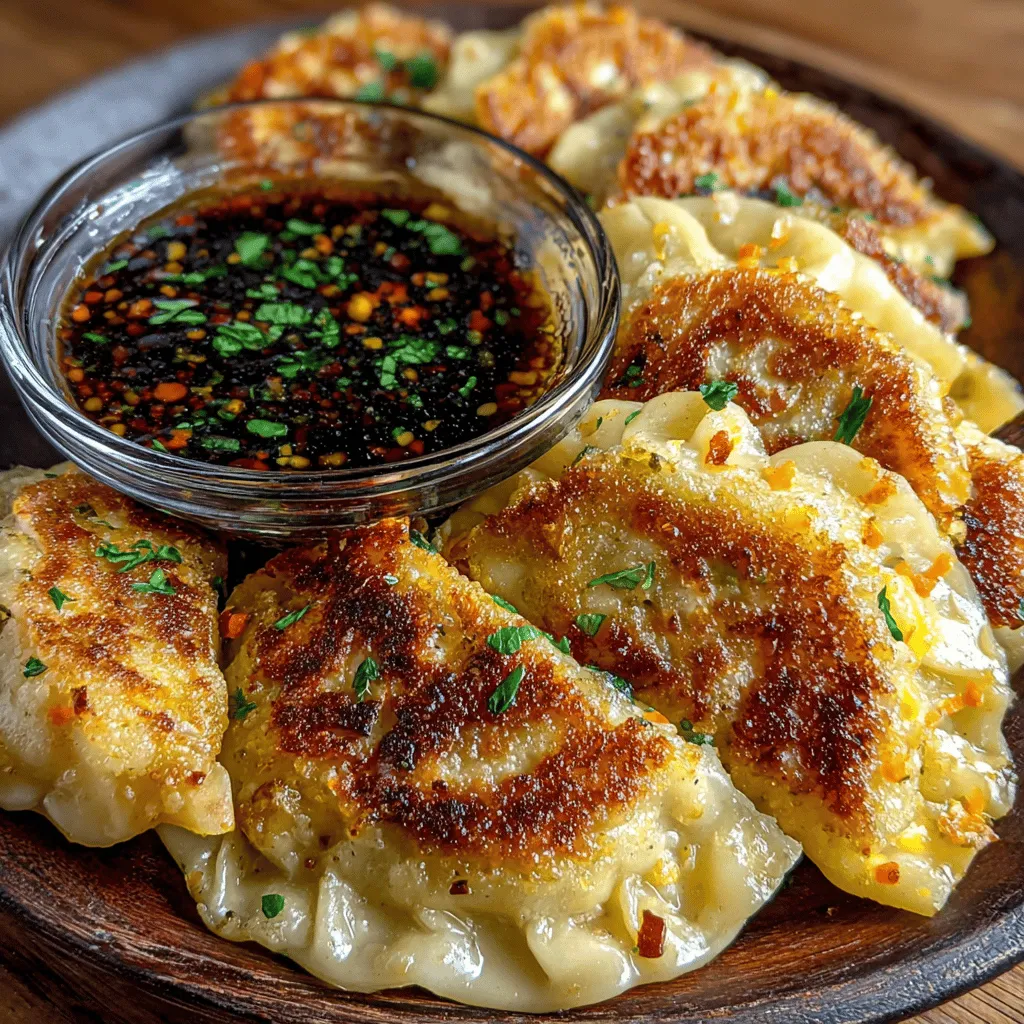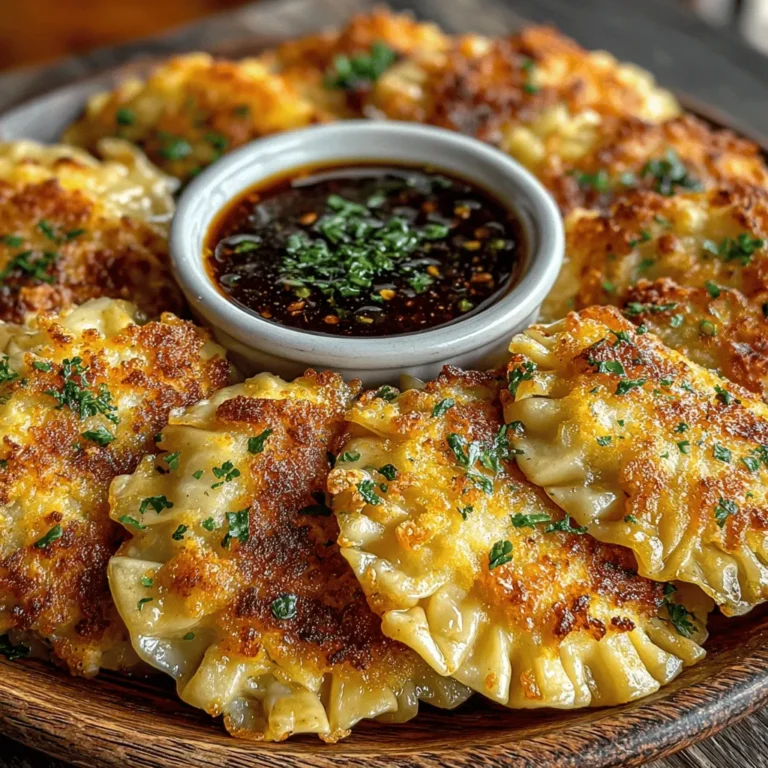Savory Chicken Potstickers Recipe
Potstickers are a beloved staple in Asian cuisine, cherished for their unique combination of textures and flavors. These delightful dumplings, with their crispy bottoms and tender tops, have won the hearts of many food enthusiasts around the world. The savory chicken potstickers, in particular, stand out with their flavorful filling and satisfying crunch. They are perfect for family meals, gatherings, or simply as a comforting snack. The blend of juicy ground chicken with fresh vegetables creates a delicious filling that is both nutritious and packed with flavor, making these potstickers a go-to recipe in many households.
Understanding Potstickers
To truly appreciate the savory chicken potstickers, it’s essential to understand what potstickers are and their origins. Potstickers, known as “jiaozi” in Chinese, are a type of dumpling that is typically pan-fried and then steamed. The cooking method results in a delightful contrast between the crispy, golden-brown bottom and the soft, steamed top. While they share similarities with other types of dumplings, such as gyoza from Japan or mandu from Korea, potstickers have their unique characteristics. The primary difference lies in the cooking technique and the type of dough used, which can vary based on regional preferences.
The cultural significance of potstickers cannot be overlooked. They are often enjoyed during Lunar New Year celebrations, symbolizing wealth and prosperity due to their coin-like shape. In many Asian cultures, potstickers are a common dish during family gatherings, where they are shared among loved ones, fostering a sense of community and togetherness.
Ingredients Breakdown
To make savory chicken potstickers, it’s crucial to have the right ingredients that will bring this dish to life. Here’s a detailed breakdown of the filling ingredients:
– Ground Chicken: The star of the filling, ground chicken provides a lean source of protein and a rich flavor that serves as the foundation of the potstickers. Its mild taste allows it to absorb the other ingredients’ flavors effectively.
– Cabbage: Shredded cabbage adds a crunchy texture and boosts the nutritional profile of the potstickers. It also helps keep the filling moist during cooking.
– Carrots: Finely grated carrots contribute sweetness and vibrant color to the filling, making the potstickers visually appealing while enhancing their flavor.
– Green Onions: These aromatic onions bring a fresh, mild onion flavor that brightens the overall taste of the filling.
– Garlic and Ginger: Essential aromatics in any Asian dish, garlic and ginger infuse the filling with depth and complexity. Their pungent flavors complement the chicken beautifully.
– Soy Sauce and Sesame Oil: These key flavor enhancers provide umami richness and a nutty aroma, elevating the overall taste of the potstickers.
– Cornstarch: Used to bind the filling ingredients together, cornstarch helps maintain the shape of the potstickers while adding a slight chewiness to the filling.
In addition to the filling, the potsticker wrappers play a vital role in the final dish. The dough is typically made from flour and water, with the right ratio crucial for achieving the desired texture. Adding a pinch of salt enhances the flavor of the wrappers.
When it comes to cooking, vegetable oil is essential for frying the potstickers to achieve that perfect crispiness. Water is then added to the pan for steaming, creating a beautiful balance between a crispy bottom and a tender top.
Finally, no potstickers are complete without a delicious dipping sauce. A simple mixture of soy sauce and rice vinegar creates a classic flavor pairing, and for those who enjoy a kick, a splash of chili oil can be added. Fresh herbs can be sprinkled on top for added brightness and freshness.
Preparation Steps
Now that you have a clear understanding of the ingredients, it’s time to dive into the preparation process. Here’s a step-by-step guide for making the savory chicken potsticker filling:
1. Prepare the Vegetables: Start by finely shredding the cabbage and grating the carrots. You can use a food processor to speed up the process. Once prepared, place the shredded cabbage in a clean kitchen towel and squeeze out any excess moisture. This step is crucial to prevent the filling from becoming too watery.
2. Mix the Filling: In a large mixing bowl, combine the ground chicken, squeezed cabbage, grated carrots, and chopped green onions. Add minced garlic and ginger to the mixture for that aromatic punch. Pour in the soy sauce and sesame oil, followed by the cornstarch. Using your hands or a spatula, mix everything thoroughly until well combined. Taste the mixture and adjust the seasoning if necessary.
3. Prepare the Wrappers: If you’re using store-bought wrappers, ensure they are thawed and ready to use. If you’re making your own, combine all-purpose flour with water and a pinch of salt to form a smooth dough. Roll it out into a thin sheet and cut out circles, typically about 3 to 4 inches in diameter.
4. Assemble the Potstickers: Take a wrapper and place about a tablespoon of the filling in the center. Be careful not to overfill, as this can make sealing difficult. Moisten the edges of the wrapper with a little water, then fold it in half and press firmly to seal. You can create pleats along the edge for a more decorative appearance, but this step is optional. Continue this process until all the filling is used.
5. Cooking the Potstickers: Heat a non-stick skillet over medium-high heat and add a tablespoon of vegetable oil. Once the oil is hot, carefully place the potstickers in the pan, ensuring they are not overcrowded. Fry them for about 2-3 minutes, or until the bottoms are golden brown.
As the potstickers fry, prepare for the steaming process by adding a few tablespoons of water to the pan (enough to cover the bottom) and immediately covering it with a lid. This will create steam, cooking the tops of the potstickers. Allow them to steam for about 5-7 minutes or until the water has evaporated.
This initial preparation sets the stage for enjoying your homemade savory chicken potstickers. The combination of crispy and tender textures, along with the flavorful filling, is sure to impress family and friends alike. Stay tuned for the next part of the article, where we’ll explore additional cooking tips, serving suggestions, and variations on this classic dish.

Mixing Techniques to Ensure Flavors Meld
To create the most delectable chicken potstickers, it’s essential to blend the ingredients thoroughly. Start by finely chopping the vegetables, such as green onions and cabbage, so they integrate well into the filling. For maximum flavor, consider briefly sautéing the vegetables in a bit of oil before mixing them with the ground chicken; this technique enhances their sweetness and releases their natural juices, creating a more flavorful filling. Additionally, ensure that you mix in seasonings such as soy sauce, ginger, and garlic evenly to allow the flavors to meld beautifully.
Instructions for Making the Dough
Importance of Kneading for Elasticity
Making the dough for potstickers is a crucial step that requires attention to detail. Begin by combining all-purpose flour and water in a bowl. It’s important to use hot water, as it helps to create a softer dough. Once the mixture starts to come together, transfer it to a lightly floured surface and knead for about 10 minutes. This kneading process is vital, as it develops gluten, which provides elasticity and strength to the dough, making it easier to roll out and shape the wrappers.
Resting Period and Its Benefits for Rolling
After kneading, wrap the dough in plastic wrap or cover it with a damp cloth and let it rest for at least 30 minutes. This resting period allows the gluten to relax, making the dough easier to roll out and shape. It’s a crucial step that can’t be skipped, as it significantly improves the texture of your potsticker wrappers.
Technique for Rolling the Wrappers
Tips for Achieving Even Thickness and Avoiding Sticking
Once the dough has rested, divide it into small portions. Roll each portion into a ball and flatten it slightly. Using a rolling pin, roll the dough out into thin circles, about 3 inches in diameter. To achieve even thickness, rotate the dough frequently while rolling, and apply consistent pressure. If the dough sticks to the surface, lightly dust it with flour as needed. Keeping the wrappers thin is key to achieving that delightful texture once cooked.
Filling and Sealing the Potstickers
Visual Cues for Proper Sealing
With your dough rolled out, it’s time to fill and seal the potstickers. Place approximately 1 tablespoon of the chicken filling in the center of each wrapper. Be careful not to overfill, as it can lead to bursting during cooking. To seal the potstickers, moisten the edges of the wrapper with water, fold it in half, and press the edges together firmly. For added security, you can pinch the edges to create a decorative seal. Look for a tight seal; this ensures that the filling stays intact while cooking.
Different Folding Techniques for Aesthetics and Texture
There are several folding techniques to choose from, each providing a unique aesthetic and texture:
1. Simple Fold: Just fold the dough in half and pinch the edges tightly.
2. Pleated Fold: Start at one end, make small folds along the edge, and pinch them together while continuing to fold. This technique not only looks impressive but also adds a delightful texture to the potstickers.
3. Crimped Edge: Use a fork to press along the edges of the sealed potstickers for a classic look.
Feel free to experiment with these techniques to find your favorite style!
Cooking Method
Detailed Description of Pan-frying
Pan-frying is the traditional method for cooking potstickers, providing that perfect crispy bottom. Heat a non-stick skillet over medium-high heat and add a tablespoon of vegetable oil. Once the oil is shimmering, carefully place the potstickers in the skillet, making sure not to overcrowd the pan.
Importance of Medium-High Heat for Crispiness
Cooking at medium-high heat is crucial; it allows for a quick sear that creates a golden brown crust. After about 2-3 minutes, or when the bottoms are properly browned, add about ¼ cup of water to the pan. Immediately cover with a lid to trap the steam inside, cooking the potstickers through.
How to Achieve the Golden Brown Bottom
To achieve that perfect golden brown bottom, avoid moving the potstickers around too much once placed in the skillet. Let them cook undisturbed until the bottoms are crispy and golden. If you notice the potstickers starting to brown too quickly, reduce the heat slightly to prevent burning.
Steaming Process Explained
After adding the water and covering, let the potstickers steam for about 5-7 minutes. The steam cooks the filling thoroughly while the bottom remains crispy. To check for doneness, carefully lift a potsticker with a spatula; the filling should be cooked through, and the dough should appear translucent.
Signs That the Potstickers Are Fully Cooked
Fully cooked potstickers will have a tender yet firm texture, and the filling should be hot throughout. The dough should not feel gummy or raw; you can also check by cutting one in half to ensure the chicken is no longer pink.
Dipping Sauce Preparation
Simple Steps for Making the Dipping Sauce
A delicious dipping sauce is essential for enhancing the flavor of your potstickers. To make a simple dipping sauce, combine soy sauce, rice vinegar, sesame oil, and a touch of sugar in a small bowl. Mix well until the sugar dissolves.
Variations on the Sauce for Different Flavor Profiles
Feel free to customize your dipping sauce to suit your taste preferences. You can add minced garlic or ginger for an extra kick, or include chili oil or sriracha for some heat. For a sweeter sauce, consider adding honey or hoisin sauce. Experimenting with different flavors can create a unique dipping experience.
Importance of Presentation in Garnishing the Sauce
To make your dipping sauce visually appealing, consider garnishing with sliced green onions or sesame seeds. This not only enhances the presentation but also adds an extra layer of flavor and texture.
Serving Suggestions
Best Practices for Serving Potstickers
When serving potstickers, presentation matters. Arrange them neatly on a serving platter with the crispy side facing up. You can accompany them with small bowls of dipping sauce on the side for easy access.
Presentation Ideas for Parties or Family Dinners
For gatherings, consider serving potstickers with a variety of dipping sauces to cater to different tastes. You can also garnish the platter with fresh herbs like cilantro or parsley for a pop of color. If you’re feeling creative, use decorative plates or bamboo steamers to enhance the aesthetic.
Pairing Suggestions with Sides or Beverages
Potstickers pair beautifully with a variety of sides and beverages. Consider serving them alongside a fresh cucumber salad or steamed vegetables for a light meal. For beverages, try pairing them with jasmine tea or a light, crisp white wine, which complements the savory flavors perfectly.
Nutritional Information
Breakdown of Calories and Nutritional Value per Serving
Each serving of savory chicken potstickers (approximately 4 potstickers) contains around 250-300 calories, depending on the filling and cooking method. The nutritional breakdown typically includes around 15 grams of protein, 10-12 grams of fat, and 30-35 grams of carbohydrates.
Discussion on the Health Benefits of Ingredients Used
The ingredients in potstickers offer various health benefits. Chicken is an excellent source of lean protein, while vegetables like cabbage and green onions provide essential vitamins and minerals. Additionally, using whole wheat flour for the wrappers can increase fiber content, contributing to a balanced diet.
Conclusion
Making savory chicken potstickers is a delightful culinary experience that brings comfort food to a whole new level. From crafting the perfect dough to mastering the art of sealing and cooking, each step allows you to create a dish that is both fulfilling and delicious.
Don’t hesitate to try this recipe; it’s an opportunity to experience the joy of homemade potstickers that can be shared with family and friends. Cooking is not just about feeding the body but also about nourishing the soul and fostering community. So gather your loved ones, and enjoy the process of making and savoring these delightful dumplings together. Whether as a main dish or an appetizer, these potstickers are sure to impress and satisfy.


